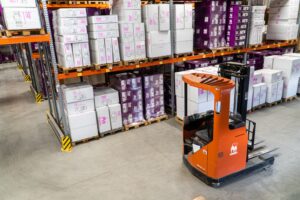In today’s dynamic and competitive business landscape, supply chain management plays a pivotal role in determining an organization’s success. Timely and accurate information is crucial for effective decision-making and ensuring the smooth flow of goods and services from suppliers to customers. Real-time tracking and visibility have emerged as game-changers in the world of supply chain management, driven by advancements in supply chain analytics. In this knowledge article, we will explore the concept of real-time tracking and visibility in supply chains and delve into the transformative impact of supply chain analytics on businesses worldwide.
Understanding Real-Time Tracking and Visibility
Real-time tracking and visibility refer to the ability to monitor and track inventory, shipments, and processes at every stage of the supply chain, from production to delivery. It involves capturing and analyzing data from various sources, such as sensors, GPS, RFID tags, and other connected devices, to provide up-to-the-minute information about the location, condition, and status of goods in transit.
Traditionally, supply chains operated with limited visibility, relying on periodic updates and manual tracking methods. This lack of real-time information led to inefficiencies, delays, and increased operational costs. However, with the advent of supply chain analytics, organizations can now access and analyze vast amounts of data in real time, enabling them to make proactive and data-driven decisions.
The Impact of Real-Time Tracking and Visibility
Enhanced Efficiency and Productivity
Real-time tracking and visibility eliminate the need for manual data collection and reduce paperwork, streamlining supply chain operations. Organizations gain a comprehensive view of their supply chains, identifying potential bottlenecks and inefficiencies promptly. With real-time data insights, businesses can optimize routes, allocate resources efficiently, and minimize downtime, leading to enhanced productivity and cost savings.
Improved Customer Experience
Customers today expect transparency and visibility throughout the supply chain. Real-time tracking empowers businesses to provide accurate and timely information about the status of orders, ensuring customers are well-informed and updated about their shipments. This improved customer experience leads to higher customer satisfaction, loyalty, and repeat business.
Effective Risk Management
Real-time tracking and visibility enable businesses to proactively identify and mitigate supply chain risks. With access to real-time data, companies can respond quickly to unforeseen disruptions, such as weather events, supplier issues, or transportation delays. By having a clear understanding of potential risks, organizations can implement contingency plans and minimize the impact of disruptions on their operations.
Inventory Optimization
Accurate and real-time visibility into inventory levels and demand patterns allows organizations to optimize inventory management. Companies can maintain optimal stock levels, avoiding stockouts or overstocking, and reducing holding costs. This leads to improved inventory turnover rates and better cash flow management.
Efficient Supply Chain Collaboration
Real-time tracking and visibility facilitate collaboration among various stakeholders in the supply chain. Suppliers, manufacturers, logistics partners, and retailers can share data and insights in real time, allowing for better coordination and synchronization of activities. This seamless collaboration fosters more efficient and effective supply chain operations.
The Role of Supply Chain Analytics
The impact of real-time tracking and visibility would not be possible without the advent of supply chain analytics. Supply chain analytics leverage technologies like big data, artificial intelligence, machine learning, and predictive modelling to process and analyses vast amounts of data generated by supply chain activities.
Data Integration and Aggregation
Supply chain analytics platforms integrate data from multiple sources, including sensors, GPS devices, ERP systems, and other business applications. By aggregating and harmonizing this data, supply chain professionals gain a unified view of their operations, providing real-time insights into inventory levels, order status, shipment tracking, and more.
Predictive Analytics for Proactive Decision-Making
Predictive analytics algorithms use historical data and patterns to forecast future supply chain events. Organizations can anticipate demand fluctuations, identify potential disruptions, and optimize inventory levels to meet customer expectations and minimize risks. This proactive decision-making ensures supply chain responsiveness and agility.
Real-Time Reporting and Dashboards
Supply chain analytics tools offer real-time reporting and interactive dashboards that display critical metrics and key performance indicators (KPIs). Supply chain professionals can monitor key metrics such as delivery times, order accuracy, and inventory turnover in real time, enabling them to identify issues and take corrective actions promptly.
Machine Learning for Continuous Improvement
Machine learning algorithms embedded in supply chain analytics platforms continuously learn from new data inputs. This enables them to adapt and refine predictions and recommendations over time, enhancing the accuracy and effectiveness of decision-making processes.
Root Cause Analysis and Performance Optimization
Supply chain analytics can perform root cause analysis to identify the underlying factors contributing to supply chain inefficiencies or disruptions. Armed with this information, organizations can implement targeted improvements and optimize their supply chain performance.
Conclusion
Real-time tracking and visibility, powered by supply chain analytics, are transforming supply chain management as we know it. The ability to access and analyze real-time data empowers organizations to make informed decisions, optimize operations, and respond swiftly to challenges and opportunities. As supply chain analytics technology continues to advance, businesses must embrace these transformative capabilities to remain competitive in the ever-evolving global market. By leveraging real-time tracking and visibility, organizations can build more resilient, agile, and customer-centric supply chains, paving the way for a prosperous and efficient future.
– Harshit Sirohi








